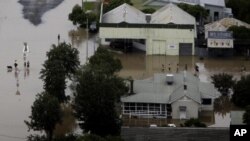Australian researchers say that social media can limit psychological damage during natural disasters. A team from the University of Western Sydney has studied the use of Facebook and Twitter during last year's deadly floods and Tropical Cyclone Yasi in the northern state, Queensland, as well as the New Zealand earthquake and the tsunami in Japan.
The university research surveyed more than 1,100 people about their use of social media during disasters.
It found that people relied on a mix of information from official government and emergency services websites, as well as informal sources.
The authors of the new study argue that social media can allow people to act as “amplifiers of official information” and also help others not to feel alone.
Researchers say Facebook and Twitter can limit the psychological damage caused by rumors and sensationalized media reporting of storms and floods and also allow communities to share their stories to a sympathetic audience.
At its peak, the Cyclone Yasi Update Facebook page, which was set up as a category five tropical storm barreled toward the Queensland coast in February 2011, had more than 92,000 members, more than 3,500 wall posts and more than 22 million 'impressions'.
Social media researcher Gwyneth Howell says the volunteers who set up the site are still helping disaster-hit areas in other parts of Australia.
“The key, amazing people that started the Yasi site are there and that core group continued to work almost as the management team all on a voluntary basis but drawing on people’s knowledge in different areas so, as other disasters unfold, they can say ‘look, this is what worked with us when we did Yasi," said Howell. "Now we are going to do the New South Wales flood site or we are going to do the Victorian flood site.’ They set it up, they provide the information, they know what worked and what did not work with Yasi and now they are just improving and enhancing the model - all through a sense of community and community spirit, which is sensational.”
The team from the University of Western Sydney says community disaster-relief sites need to be carefully managed to ensure “trolls” are banned quickly, along with advertisers and scammers.
Psychologist Mel Taylor says most people who post messages and information during natural disasters are genuine.
“In the heat of the disaster there are very few mischief-makers who really want to get in there and upset things, so I think people are well-intended," said Taylor. "If information is inaccurate it is unintentional at least.”
The study, called "When a Crisis Happens who Turns to Facebook," has been carried out to help the authorities, including the emergency services, understand the role and power that social media can have during natural disasters.








